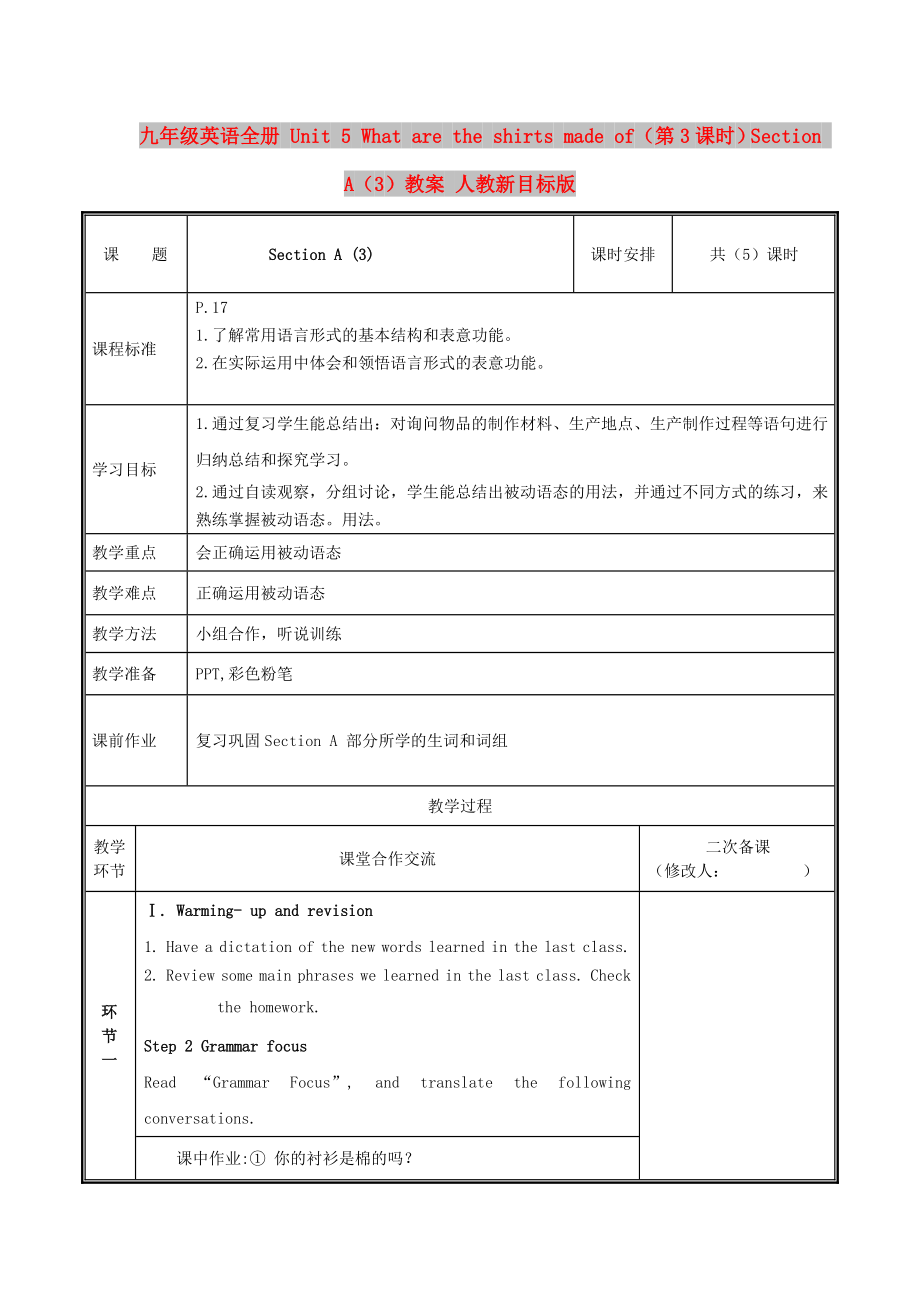《九年級英語全冊 Unit 5 What are the shirts made of(第3課時)Section A(3)教案 人教新目標版》由會員分享��,可在線閱讀�����,更多相關(guān)《九年級英語全冊 Unit 5 What are the shirts made of(第3課時)Section A(3)教案 人教新目標版(6頁珍藏版)》請在裝配圖網(wǎng)上搜索�。
1��、九年級英語全冊 Unit 5 What are the shirts made of(第3課時)Section A(3)教案 人教新目標版
課 題
Section A (3)
課時安排
共(5)課時
課程標準
P.17
1.了解常用語言形式的基本結(jié)構(gòu)和表意功能�。
2.在實際運用中體會和領(lǐng)悟語言形式的表意功能。
學習目標
1.通過復(fù)習學生能總結(jié)出:對詢問物品的制作材料�����、生產(chǎn)地點����、生
2、產(chǎn)制作過程等語句進行歸納總結(jié)和探究學習。
2.通過自讀觀察��,分組討論��,學生能總結(jié)出被動語態(tài)的用法����,并通過不同方式的練習,來熟練掌握被動語態(tài)�����。用法��。
教學重點
會正確運用被動語態(tài)
教學難點
正確運用被動語態(tài)
教學方法
小組合作�,聽說訓練
教學準備
PPT,彩色粉筆
課前作業(yè)
復(fù)習鞏固Section A 部分所學的生詞和詞組
教學過程
教學環(huán)節(jié)
課堂合作交流
二次備課
(修改人: )
環(huán)
節(jié) 一
Ⅰ. Warming- up and revision
1. Have a dictation of the new words learned
3、 in the last class.
2. Review some main phrases we learned in the last class. Check the homework.
Step 2 Grammar focus
Read “Grammar Focus”, and translate the following conversations.
課中作業(yè):① 你的襯衫是棉的嗎��?
____ your shirts ____ ____ cotton?
② 是的��,而且它們產(chǎn)于美國����。
Yes. And they were _____ ___
4、the US.
③ 飛機模型是由什么制成�����?
______ the model plane ______ of ?
④ 它是由舊木頭和玻璃制成。
It’s made of _____ ______ and ______
⑤ 茶產(chǎn)自中國哪里���?
_______ ____ tea ___________ in China?
⑥ 茶產(chǎn)自很多不同的地區(qū)����。
It’s produced in many ________ _______.
⑦ 茶是如何制成的���?
_____ is tea _________
5����、_?
⑧ 茶樹種植在山坡上��。當茶葉長成后�����,它們被手工采摘下來��,然后送去加工����。
Tea plants ______ ______ on the sides of the mountains. When the leaves are ready they _____ ______ by hand and then ______ ______for _________.
⑨ 在杭州人們種植茶葉。
People_______ ________ in Hang Zhou.
Tea _____ ________ (by people) in Hang Zhou.
6����、
環(huán)
節(jié)
二
Ⅲ. Summary
一、被動語態(tài)
當主語為動作的執(zhí)行者時, 謂語的形式為主動語態(tài); 當主語為動作的承受者時, 謂語要用被動語態(tài)�。
e.g. Many people speak English.
(主動語態(tài), 句子的主語many people是動作speak的執(zhí)行者)
English is spoken by many people.
(被動語態(tài), 句子的主語English是動作speak的承受者)
被動語態(tài)主要用于以下幾種情況:
1.?強調(diào)動作的承受者。如:
The English-Chinese d
7�����、ictionary is used by most students.
2.?不知道動作的執(zhí)行者��。如:
The book was published (出版) last year.
3.?沒有必要提及執(zhí)行者��。如:
Such things are not done twice.
4.?被動語態(tài)的使用往往受上下文和語境支配�。在一個句子中有時為了避免中途變更主語而不得不使用被動語態(tài)。如:
Jack played Mike at ping-pong and (Jack) was easily beaten.
5.?有些動詞習慣上常用被動語態(tài)�����。如:
Tim is though
8�����、t to be the best student in our class.
二��、被動語態(tài)的構(gòu)成
與主動語態(tài)一樣,被動語態(tài)也有時態(tài)�����、人稱和數(shù)的變化, 其變化規(guī)則與be作為連系動詞時完全一樣����。
一般現(xiàn)在時被動語態(tài)的構(gòu)成:
be (am / is / are) +及物動詞的_____分詞?
The book is written in Chinese.
The book isn’t written in Chinese.
一般疑問句:
—Is the book written in Chinese?
—Yes, it is. / No, it isn’t.
特殊疑問句:
W
9、hat language is the book written in?
?
肯定式
否定式
疑問式
一般
現(xiàn)在時
I am asked …
He/She is asked …
We/You/They are
asked…
I am not asked…
He/She is not asked…
We/You/They are not asked …
Am I asked …?
Is he/she asked …?
Are we/you/they
asked …?
課中作業(yè)
1. – Don’t smoke
10���、here, Dad. Smoking ____ in public places.
– Oh, sorry. I’ll stop right not. (xx福建福州)
A. isn’t allowed B. aren’t allowed C. doesn’t allow
2. Everyone in our class ____ to take part in the English Speech Contest. (xx山東煙臺)
A. is encouraged B. encourages
C. are encour
11��、aging D. are encouraged
3. To our surprise, the walls of the new book store ____ books. (xx福建廈門)
A. are lined with B. is lined with C. have lined with
4. Chengdu is a greener city now because more and more trees _____ every spring. (xx四川成都)
A. were planted B. are planted
12���、 C. will be planted
5. – Can Mr. King spare some time for the charity show?
– If he ____, he will try his best to make it. (xx江蘇鹽城)
A. will be invited B. is invited
C. invites D. invited
6. The novel _____ by many people today. (xx天津)
A. is read
13、 B. are read C. reads
環(huán)
節(jié)
三
V. Talking
1. Ask five classmates about something they are wearing or have in their schoolbags. The list of words below may help you. (Learn some new words.)
2. Let one pair read out the conversation in the box as a model.
3. 提示學生們運用左側(cè)方框中的示例詞��。
4.
14��、讓學生們以小組為單位分別自主發(fā)揮�,用英語談?wù)撟约旱奈锲返闹谱鞑牧霞吧a(chǎn)地點�。
課中作業(yè)
4a,4b,4c
課后作業(yè)設(shè)計:
Homework
將下列句子變成被動語態(tài)句
1. We use puters to search information.
2. The teacher often repeats the story.
3. They don’t allow fishing here.
4. Bill looks after his cat carefully.
5. We don’t often speak English at home.
(修改人: )
板書設(shè)計:
教學反思:
 九年級英語全冊 Unit 5 What are the shirts made of(第3課時)Section A(3)教案 人教新目標版
九年級英語全冊 Unit 5 What are the shirts made of(第3課時)Section A(3)教案 人教新目標版

